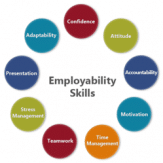Lifelong Learning to Lifelong Employability
Half of today’s work activities coordinated by humans could be automated with present-day technology. Few organizations or individuals are prepared for such a transition. There is a significant gap, brought on by digitization and advanced data analytics, between the skills people have and the skills companies need. McKinsey Global Institute (MGI) produced reports and analysis gives both industry and education a reflection of current and future needs.
We need to change the dialog. Employers, employees, educational institutions, and public-sector leaders need to start talking about “lifelong employability”: helping people continually and successfully adapt as the economy evolves.
We currently use the term, “Lifelong Learning,” tends to be an academic term that appeals to the highly educated, but less exciting to the normal student. Industry needs to help workers remain relevant and ensure that employers have the flow of skilled workers they need and could even improve retention by exciting employees about their career prospects and potential. We need to discontinue using terms like “retraining” and “reskilling,” as if they’re something that happens after a layoff or when a process or piece of equipment is installed. Or, “remedial,” which imply the learner is broken in some way. Research indicates that fear or risk of failure can shut down neural pathways crucial to learning. Similarly, organizations should be thoughtful about the use of assessments: tests can be stressful and may contribute to people dropping out. The best learning environments support employees—and don’t stress them out.
Think Competence, Not College: A four-year degree is not necessary for all professional jobs, nor is it a sure indicator of ability or mastery of a body of knowledge. Therefore, it’s worthwhile to consider and recognize alternative credentials in recruiting, retention, and job placement.
Lifelong employability offers a way to meet the challenges of an evolving workforce and the rise of automation with a sense of aspiration and hope, rather than fatalism and patchwork solutions. It’s also crucial for long-term corporate survival and for national competitiveness. By changing how they think about L&D, senior executives can get ahead of the challenge and start making a better workplace for everyone.
Many companies approach learning and development (L&D) much as they did 30 years ago. That is, they rely on classrooms for training and take a one-size-fits-all approach. It shouldn’t be this way. Organizations should take advantage of the solid research, grounded in neuroscience, psychology, sociology, and pedagogy, about what works in learning in general and adult learning in particular. For example:
- Studies show that relationships help learning by stimulating the parasympathetic nervous system. Study groups can therefore help people process new ideas and learn more than when they work alone.
- Training courses are most effective when they are tailored for specific roles and at identifiable career inflection points, as opposed to being offered episodically, according to the calendar, or when HR secures resources for new learning initiatives.
- Microlearning—presenting information in short, 15- to 30-minute bursts—is more effective than longer sessions. Companies can experiment with digital technologies such as virtual or augmented reality to take advantage of this. They can also explore other digital options, such as self-directed online learning and artificial intelligence, to make the provision of training more flexible.
- Big data can help customize and measure learning experiences. Few L&D departments have invested in data analytics the way other departments have. Marketers, for example, know what time of day people open their messages most frequently, how long they engage, and what methods capture them most. L&D courses and programs should be no different.
The information source for this post is the Mckinsey Co
https://www.mckinsey.com/featured-insights/future-of-work/competitive-advantage-with-a-human-dimension-from-lifelong-learning-to-lifelong-employability
As AI-enabled automation advances, organizations should embrace “lifelong employability,” which stretches traditional notions of learning and development and can inspire workers to adapt, more routinely, to the evolving economy.

